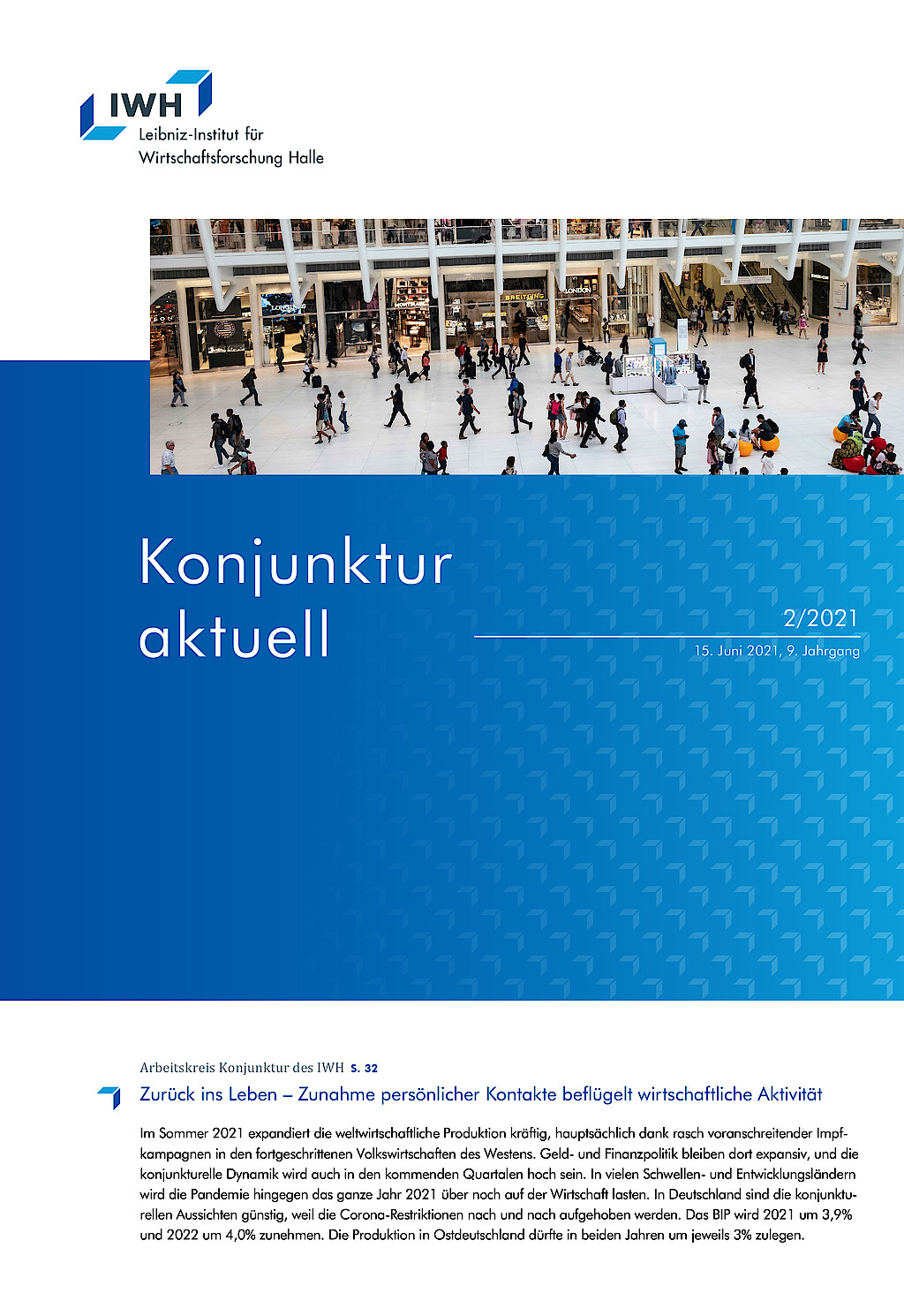Increase in personal contacts spurs economic activity

Global economic production expands strongly in the summer of 2021. The main reason is that the pandemic is in retreat from the advanced economies of the West, where vaccination campaigns are progressing rapidly. World industrial production, however, has recently stopped growing. This is due to a variety of bottlenecks in production and a lack of transport capacities. Higher prices, especially for raw materials, have recently caused inflation rates to rise significantly. Monetary policy, like fiscal policy, nonetheless remains expansive in the advanced economies. While economic momentum in these countries will be high in the coming quarters, the picture is more differentiated elsewhere: In China, the catch-up process is already complete, and while commodity producers are benefiting from higher prices, the pandemic will continue to weigh on the economy of many emerging and developing countries throughout 2021.
A downside risk for the German economy is the possibility that life returns to normal at a time when herd immunity has not yet been reached and that the pandemic therefore flares up again in the summer
In Germany, the pandemic severely dampened economic activity until April. However, registered unemployment did not rise, also due to short-time work regulations. Real disposable income was, in spite of the crisis, almost at the pre-crisis level already at the beginning of the year, while private consumption was 11% lower. It will pick up strongly in the course of the summer as economic life returns to normal. This will particularly benefit the retail trade, the hospitality industry and other providers of leisure activities. Foreign demand for manufacturing products will also provide a strong stimulus. However, supply bottlenecks in the manufacturing sector are slowing the pace of expansion in Germany as elsewhere. It will probably take until the end of 2022 before capacity utilisation is back to normal. The employment situation will start to improve in the second quarter of 2021, and registered unemployment will be declining in the course of 2021. Inflation will remain well above 2% in the coming months, mainly due to base effects in the oil price. Because fiscal policy is still expansionary in 2021, the general government budget deficit will rise from 4.5% in relation to gross domestic product (GDP) to 5.1% despite the economic recovering. In 2022, the deficit will decline significantly to 1.4%.
“A downside risk for the German economy is the possibility that life returns to normal at a time when herd immunity has not yet been reached and that the pandemic therefore flares up again in the summer,” says Oliver Holtemöller, head of the Department Macroeconomics and vice president at the IWH, “this could delay the catch-up process again.” In addition, supply bottlenecks could weigh even more heavily on the manufacturing sector than assumed in this forecast. An upside risk is the possibility that more of the income saved during the crisis will be spent. Higher output growth and stronger price dynamics would be the result.
The extended version of the forecast (Konjunktur aktuell: Zunahme persönlicher Kontakte beflügelt wirtschaftliche Aktivität) contains the following two info boxes:
Box 1: Assumptions and forecasts regarding the general conditions (in German)
Box 2: Estimation of production potential (in German)
Publication: Brautzsch, Hans-Ulrich; Claudio, João Carlos; Drygalla, Andrej; Exß, Franziska; Heinisch, Katja; Holtemöller, Oliver; Kämpfe, Martina; Lindner, Axel; Müller, Isabella; Schultz, Birgit; Staffa, Ruben; Wieschemeyer, Matthias; Zeddies, Götz: Zunahme persönlicher Kontakte beflügelt wirtschaftliche Aktivität. IWH, Konjunktur aktuell, Jg. 9 (2), 2021. Halle (Saale) 2021.
Whom to contact
For Researchers

Vice President Department Head
If you have any further questions please contact me.
+49 345 7753-800 Request per E-MailFor Journalists

Internal and External Communications
If you have any further questions please contact me.
+49 345 7753-832 Request per E-MailIWH list of experts
The IWH list of experts provides an overview of IWH research topics and the researchers and scientists in these areas. The relevant experts for the topics listed there can be reached for questions as usual through the IWH Press Office.
Related Publications

Konjunktur aktuell: Zurück ins Leben – Zunahme persönlicher Kontakte beflügelt wirtschaftliche Aktivität
in: Konjunktur aktuell, 2, 2021
Abstract
Im Sommer 2021 expandiert die weltwirtschaftliche Produktion kräftig, hauptsächlich dank rasch voranschreitender Impfkampagnen in den fortgeschrittenen Volkswirtschaften des Westens. Geld- und Finanzpolitik bleiben dort expansiv, und die konjunkturelle Dynamik wird auch in den kommenden Quartalen hoch sein. In vielen Schwellen- und Entwicklungsländern wird die Pandemie hingegen das ganze Jahr 2021 über noch auf der Wirtschaft lasten. In Deutschland sind die konjunkturellen Aussichten günstig, weil die Corona-Restriktionen nach und nach aufgehoben werden. Das BIP wird 2021 um 3,9% und 2022 um 4,0% zunehmen. Die Produktion in Ostdeutschland dürfte in beiden Jahren um jeweils 3% zulegen.



